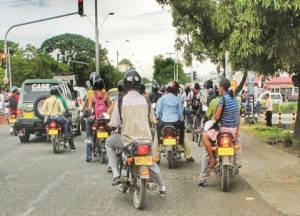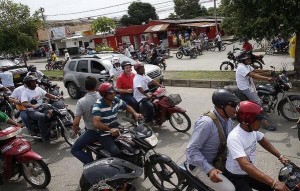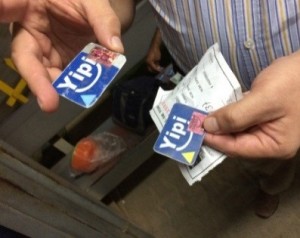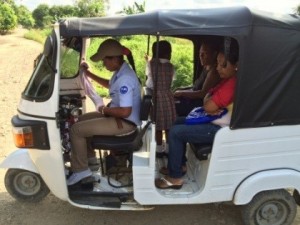By Cassie Gianni
Introduction
In cities throughout Colombia, moto-taxi services create informal jobs for drivers and provide quick and low cost transportation for riders. Public officials recognize these benefits, but worry about the increased dangers and pollutants from motorbikes. Despite large national investment in public transport, the rise of moto-taxis has caused the share of public transit to decrease by 5-10% in many Colombian cities. Montería stands out as an exception where public transport ridership continues to steadily increase by approximately 10% per year. Metrosinú, a local bus company, credits the expansion to its ‘Yipi’ service, which is based on the moto-taxi concept. Instead of building a traditional feeder system with buses, the city’s bus operators developed a micro-feeding scheme that provides three-wheeled, low-floor, covered motorbikes to pick people up and drive them to the nearby bus.


i rickshaws have safer physical structure and emit less pollutants than moto-taxis. They operate in zones defined by GPS geo-fencing from a control center with 24/7 surveillance. People can call or text, and a Yipi ride in the zone will arrive at their location within five minutes. This pick-up service, along with the more accommodating space of the rickshaw, improves access for the disabled and elderly. Not only are the Yipi rides free, but people who utilize Yipi also get a discount on bus fare. Beyond increasing safety, access, and affordability of public transit, Yipi services also promote gender sensitivity and empowerment. Yipi proactively seeks to train and employ female drivers in order to provide them with formal sector jobs that pay well, remain stable, and offer flexible hours. Of equal importance, women passengers can request women drivers in order to feel safer while traveling.
Analysis
In Montería, public officials worry about the vulnerability of women on moto-taxis. Most moto-taxi drivers are men, and a significant number of cases have occurred in which the male drivers took advantage of female passengers. Not only were women’s bodies, like those of all other passengers, endangered by structural insecurities of motorbikes, but their bodies also faced another potential danger based on their gender. Trying to decrease the visceral experiences of violence and fear for women, Metrosinú designed Yipi services to ensure a higher degree of safety – rickshaws are more structurally secure than motorbikes, and women can specifically request female drivers at any time. Additionally, the structure of the rickshaws and pick-up service both ensure more comfort and safety for the bodies of disabled and elderly individuals when they travel around the city.


Metrosinú conceptualized Yipi rides not only as transportation services, but also as temporary, shared, semi-private spaces in motion. Drivers largely control these spaces as directors of the rickshaw’s movement. Meanwhile, passengers enter, co-habitat the space, and then exit once the ride ends. During the ride, passengers must trust the driver for their safety. The bus company wanted to create structurally safe and accessible spaces for all passengers, including the disabled and elderly, as they travel in the rickshaws. Additionally, the option for female passengers to request female drivers demonstrates clearly Yipi’s proactive efforts to create mobile spaces in which women feel secure.
To further promote women’s empowerment, Metrosinú considered the agency of the people, or drivers and passengers, as well as that of the objects, or the rickshaw. The interactions between all these materials of public space are constantly changing, and each interaction cultivates a form of productivity and infrastructure. While women are generally conceptualized as passengers of moto-taxis and public transit, Yipi rickshaws empower women to now also enjoy agency as drivers. Metrosinú identified the valuable opportunity for partnership between the women and rickshaws. Women drivers and rickshaws interact to provide a service and create revenue; simultaneously, women passengers and rickshaws co-function as travel companions through the city.
Implications
I first applied concepts of visceral geography to analyze women’s bodies in transit as sites of possible attack, and to understand how Yipi intentionally tries to prevent women from experiencing fear and violence. Next, I conceptualized Yipi as a temporary, shared, semi-private space in motion that is created with consideration for the safety and comfort of passengers, including and especially women. Finally, I considered women and the rickshaws as co-functioning agents with shifting roles – women drivers partner with the rickshaws to provide transit, while women passengers and rickshaws interact as travel companions.
I arrived at this analysis of Yipi by drawing on three critical approaches to the understanding of space in international planning.
First, I drew on the work in visceral geography, which sees the body as a geographical space of inquiry and focuses on how bodies feel internally, in relation to surrounding spaces and environments. Internal feelings can include sensations, moods, and physical states of being. I was particularly inspired by the approach of Elizabeth Sweet and Sara Ortiz Escalante (2014) to visceral geographies, in terms of fear and gender violence. Sweet and Escalante specifically study the visceral geography of women and their bodies, since women are too often victims of gender violence.
Second, I was informed by research in “the new mobilities paradigm”, in particular the exploration of Mimi Sheller and John Urry (2006) into the movement of people and ideas and how these interact with and define spaces. A central focus of the mobilities paradigm is analyzing the impact of transportation, including public transit. Instead of thinking about places as fixed, given, and separate from the people visiting or passing through, the mobilities paradigm challenges planners to consider places as situated within complex networks by which people, infrastructure, and objects are contingently brought together to produce certain performances in certain places at certain times.

Third, my analysis is inspired by assemblage theory, which calls for research to give equal weight to both human and non-human actors and study the assemblies of space they create in concert. I drew, in particular, on the assemblage theorizing in urban design by Pablo Sendra (2015). AbdouMaliq Simone (2004) deploys assemblage theory to conceptualize infrastructure to include people’s activities as well as the physical elements of the city. He examines the ability of residents to interact with complex combinations of objects, spaces, persons, and practices, in ways that provide for and reproduce life in the city.
Planners can and should analyze the visceral feelings of human bodies, the dynamics of mobility, and the shifting interactions between human and non-human public materials, especially when considering transportation designs. These frameworks require paying attention to micro-scale geographies like the body, considering both physical and emotional impacts on people, problematizing assumptions of sedentarism and permanence, giving equal weight to the role of non-human objects, and recognizing the role of gender, race, and other factors of identity on how people experience space. Rather than complicating planning, these theories will reveal the complex contexts and often unintended consequences of planning decisions. Every layer of analysis enhances understanding, and aids planners in approaching multidimensional challenges with equally multifaceted designs.
